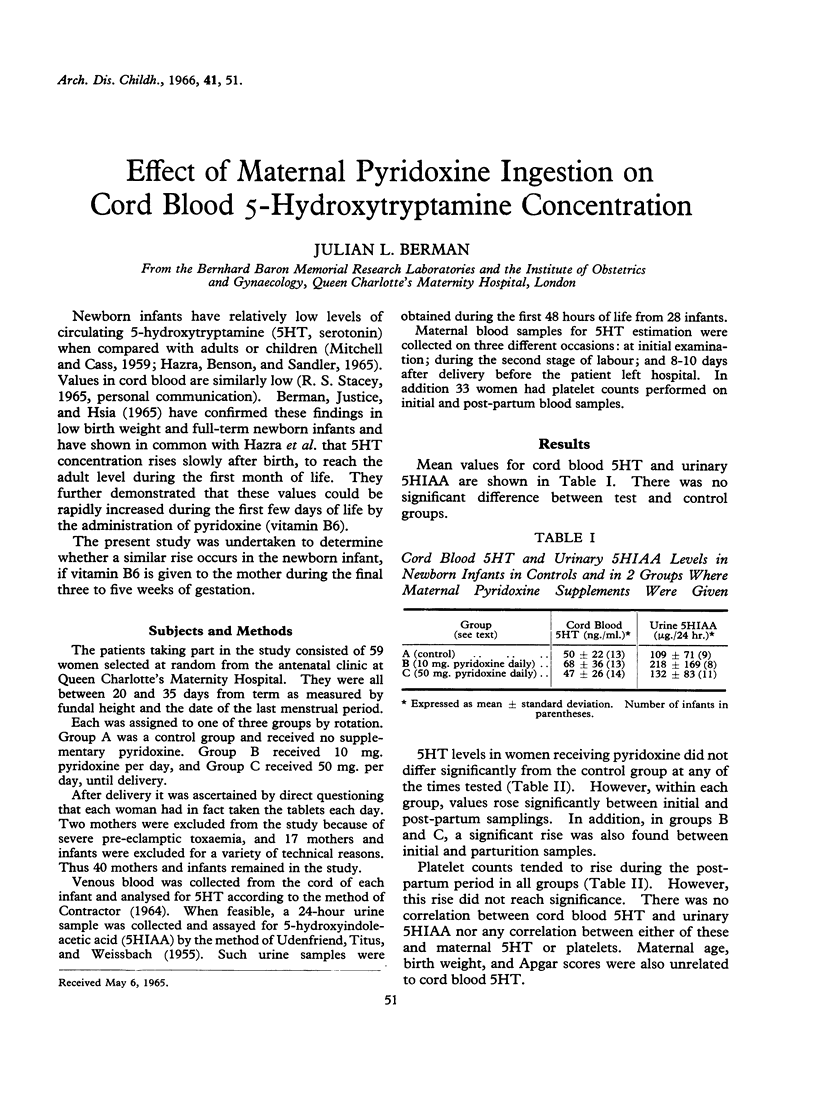Full text
PDF


Selected References
These references are in PubMed. This may not be the complete list of references from this article.
- BUZARD J. A., NYTCH P. D. The relation of dietary pyridoxine to the 5-hydroxytryptophan decarboxylase activity of rat kidney. J Biol Chem. 1957 Nov;229(1):409–413. [PubMed] [Google Scholar]
- Berman J. L., Justice P., Hsia D. Y. The metabolism of 5-hydroxytryptamine (serotonin) in the newborn. J Pediatr. 1965 Oct;67(4):603–608. doi: 10.1016/s0022-3476(65)80431-0. [DOI] [PubMed] [Google Scholar]
- CONTRACTOR S. F. THE ESTIMATION OF 5-HYDROXYTRYPTAMINE IN HUMAN BLOOD. Biochem Pharmacol. 1964 Sep;13:1351–1357. doi: 10.1016/0006-2952(64)90235-7. [DOI] [PubMed] [Google Scholar]
- COURSIN D. B., BROWN V. C. Changes in vitamin B6 during pregnancy. Am J Obstet Gynecol. 1961 Dec;82:1307–1311. doi: 10.1016/s0002-9378(16)36258-5. [DOI] [PubMed] [Google Scholar]
- DAHLER R. P. [Investigations of tryptophane degradation and vitamin B-6 metabolism in the newborn and in the young infant]. Ann Paediatr. 1963;200:346–362. [PubMed] [Google Scholar]
- DRISCOLL S. G., HSIA D. Y. Y. The development of enzyme systems during early infancy. Pediatrics. 1958 Oct;22(4 Pt 2):785–845. [PubMed] [Google Scholar]
- HUANG I., TANNENBAUM S., HSIA D. Y. Development of 5-hydroxytryptophan decarboxylase activity in rat kidney. Nature. 1960 May 28;186:717–718. doi: 10.1038/186717a0. [DOI] [PubMed] [Google Scholar]
- Hazra M., Benson S., Sandler M. Blood 5-hydroxytryptamine levels in the newborn. Arch Dis Child. 1965 Oct;40(213):513–515. doi: 10.1136/adc.40.213.513. [DOI] [PMC free article] [PubMed] [Google Scholar]
- JOLLES-BERGERET B., LABOUESSE J., CHATAGNER F. [Influence of thyroid hormones on the desulfuration of cysteine by rat liver. Comparison of the behavior of the desulfuration with that of other enzymatic reactions requiring pyridoxal phosphate]. Bull Soc Chim Biol (Paris) 1960;42:51–63. [PubMed] [Google Scholar]
- MCCORMICK D. B., GREGORY M. E., SNELL E. E. Pyridoxal phosphokinases. I. Assay, distribution, I. Assay, distribution, purification, and properties. J Biol Chem. 1961 Jul;236:2076–2084. [PubMed] [Google Scholar]
- MITCHELL R. G., CASS R. Histamine and 5-hydroxytryptamine in the blood of infants and children. J Clin Invest. 1959 Apr;38(4):595–604. doi: 10.1172/JCI103837. [DOI] [PMC free article] [PubMed] [Google Scholar]
- NACHMIAS V. T. Amine oxidase and 5-hydroxytryptamine in developing rat brain. J Neurochem. 1960 Sep;6:99–104. doi: 10.1111/j.1471-4159.1960.tb13455.x. [DOI] [PubMed] [Google Scholar]
- POGRUND R. S., DRELL W., CLARK W. G. Metabolism of 3-hydroxy- and 3,4-dihydroxyphenylpyruvic acids in vivo. J Pharmacol Exp Ther. 1961 Mar;131:294–307. [PubMed] [Google Scholar]
- SCARDI V., IACCARINO M., SCARANO E. The action of sulphate and phosphate esters of oestrogens on the reconstitution of two pyridoxal 5-phosphate-dependent enzymes. Biochem J. 1962 May;83:413–416. doi: 10.1042/bj0830413. [DOI] [PMC free article] [PubMed] [Google Scholar]
- UDENFRIEND S., TITUS E., WEISSBACH H. The identification of 5-hydroxy-3-indoleacetic acid in normal urine and a method for its assay. J Biol Chem. 1955 Oct;216(2):499–505. [PubMed] [Google Scholar]
- YAMADA K., YAZAKI C., SAWAKI S., UTUMI S. Inhibitory effect of growth hormone on some vitamin B6 enzyme systems of Escherichia coli. J Vitaminol (Kyoto) 1958 Dec 10;4(4):274–277. doi: 10.5925/jnsv1954.4.274. [DOI] [PubMed] [Google Scholar]
- ZARTMAN E. R., BARNES A. C., HICKS D. J. Observations on pyridoxine metabolism in pregnancy. Am J Obstet Gynecol. 1955 Sep;70(3):645–649. doi: 10.1016/0002-9378(55)90360-4. [DOI] [PubMed] [Google Scholar]


